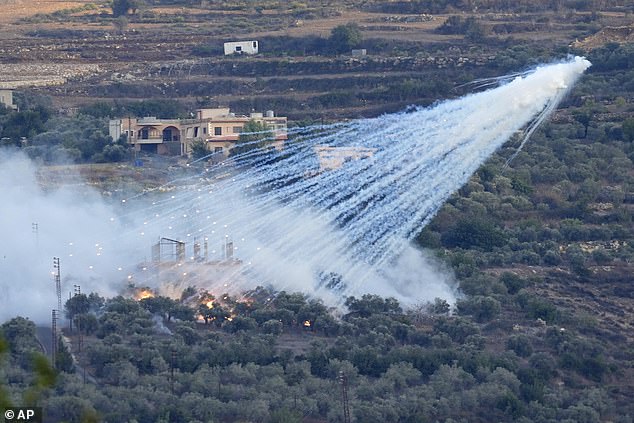When you grow up here, the blood in your veins is a different temperature — it boils all day long,’ says Lior Shelef. ‘People here love a good fight. It seems like human nature.’
The 48-year-old Israeli infantry veteran should know. He has seen more than half a dozen conflicts here in the small kibbutz of Snir that sits on Israel’s scorching northern border with Lebanon.
Just a few hundred metres from his garden lies the mountainous frontier between the two countries which teems with thousands of Hezbollah terrorists.
Armed and funded by Iran, they constitute the largest non-state army on the planet with some 50,000 foot soldiers, hundreds of thousands of rockets and thousands of drones.

A shell from Israeli artillery explodes over a house in al-Bustan, a Lebanese border village with Israel, south Lebanon

When you grow up here, the blood in your veins is a different temperature — it boils all day long,’ says Lior Shelef, pictured with his dog Mancha. ‘People here love a good fight. It seems like human nature.’
They can overwhelm Tel Aviv’s Iron Dome air defences and hit critical targets anywhere in Israel.
Despite expressing support for Hamas following its October 7 assault and hitting Israel with rockets in a show of solidarity, Hezbollah has so far confined its attacks to the north of the country.
There have been almost daily exchanges of fire over the border between the two countries since October. Hundreds have been killed and 160,000 displaced from communities on both sides. But the conflict in the north has largely remained a sideshow to the war in Gaza.
Ominously, however, the mood in recent weeks has changed and there are now fears of an all-out war between Israel and Hezbollah — a terrifying prospect which could quickly pitch America directly against Iran and perhaps be the spark that ignites a third world war.
This month, in response to the killing of one of its senior commanders, Mohammed Nimah Nasser, in an Israeli air-strike in southern Lebanon, Hezbollah launched more than 100 rockets at Israeli military positions. Meanwhile, the IDF has been moving troops and tanks northwards in large numbers.
After October 7, some 100,000 IDF soldiers were despatched to the border but thousands more are reported to have followed in the past few weeks and social media has shown lines of Israeli Merkava tanks as well as M113 personnel carriers and self-propelled guns heading there in the past month.
It is understood the air force and intelligence units are also moving into position.
While diplomats in Washington are pushing for a peaceful solution, those living here are resigned to what comes next: they warn the West it is not a question of if full-scale war will break out — but when.

The Blue Line demarcation line dividing Lebanon from Israel. There are now fears of an all-out war between Israel and Hezbollah — a terrifying prospect which could quickly pitch America directly against Iran and perhaps be the spark that ignites a third world war

A destroyed home in the south of Lebanon. Locals in this region of north Israel say their warnings of the looming conflagration have gone unheeded for years
The Mail travelled to both sides of the border to witness the destruction wreaked by the fighting since October — as well as assess the implications of a wider conflict. Over two weeks of dodging rocket fire across Lebanon and Israel, we uncovered a devastating story — one of a monumental failure of diplomacy that could lead to a war that flattens Lebanon, causes catastrophe in Israel and makes events in Gaza look like a fringe event.
Locals in this region of north Israel say their warnings of the looming conflagration have gone unheeded for years.
Before October 7, Sergeant Shelef was a tour guide who took visitors up onto Mount Dov, part of the ridge-line that separates Israel from Lebanon.
To the south he could see the idyllic Hula Valley, home to sprawling cattle ranches and fruit orchards that were fast making this region Israel’s gastronomic and agricultural heartland.
To the north, however, nestled in the rolling hills, Shelef could see something more sinister. ‘Every day I was looking eye to eye with Hezbollah,’ he tells us as the 37C (98F) heat beats down in his deserted village. The terror group shouldn’t have been so close to the border.
The IDF last invaded its northern neighbour after Hezbollah kidnapped two soldiers in a cross-border raid, sparking the Lebanon War in 2006. A UN resolution brought the 34-day conflict to an end. It guaranteed that no armed militants would come south of the Litani River in Lebanon — roughly 18 miles from Israel and beyond the reach of Hezbollah’s dreaded anti-tank fire.
But, as Shelef and his tour groups could see, the 11,000 soldiers from the United Nations Interim Force Lebanon (UNIFL) set up to enforce this had failed in their task. Out-muscled by a far larger and more hostile Hezbollah force, UNIFL’s strict rules of engagement left it no option but to cede the territory.
In its stead, the Iran-backed militia then armed itself to the teeth, amassing a fearsome array of weapons just metres from the tens of thousands of Israelis who live on the border.
Meanwhile, Israel repeatedly breached the resolution by flying over Lebanese airspace and entering their waters. ‘Consecutive Israeli cabinets cheated themselves that peacefulness means peace,’ says Amit Segal, political commentator for Channel 12, Israel’s biggest TV station. ‘What we got at the end of those 18 years of denial is the biggest threat to Israel’s population in its history.
‘Since its independence war, this is the first time there is an army or terrorist organisation in the Middle East that can, with one decision, kill hundreds of citizens, destroy thousands of buildings, and threaten each and every single point in the State of Israel.’
On October 7, the ‘peacefulness’ was broken when Hamas poured over the Gaza border to kill 1,200 people, including babies and young children, committing mass rape and taking hundreds of hostages into its tunnels beneath Gaza.
While those living in the north were more than 150 miles away, it was a terrifying warning of what could happen and was to have a dramatic effect of their lives.
The next day, Hezbollah’s leader, Hassan Nasrallah, ordered his terrorist force to start barraging the north of Israel with rocket fire.
Within a fortnight, an Israel reeling from the trauma of October 7, and fearing a similar attack in the north, gave the unprecedented order to evacuate the region. ‘All hell broke loose,’ remembers Shelef, who now lives alone with his five-year-old dog, Mancha. His wife May, 43, a dance therapist, left with their children Ethan, ten, Alma, eight, and Ori, five.
Hezbollah started by ‘bothering’ border villages with rocket fire, before aiming further south after they fled, in arching strikes that set off alarms throughout Upper Galilee. Then, as temperatures soared, they began to destroy the land, starting fires that laid waste to Israel’s vital agricultural sector.
The plan is to force Israel to negotiate with Hamas and withdraw from Gaza. This is the price of peace in the north.
Hezbollah’s tactics have already devastated the local economy, robbing it of its workforce and destroying agricultural resources. The evacuation has also taken its domestic toll, with a surge in divorces after nine months of evacuated families living in hotels far from their homes.
Such was the mental torment for Erez Bergman, 51, who had been evacuated for six months, that he returned to Snir two months ago with his wife Maya, 42, a council worker, and their children Ella, 13, and Mika, nine.

Erez Bergman, 51, had been evacuated for six months from Snir, before returning two months ago with his wife and two children

The family only live in one side of the home as ‘the other side points to the direction of Lebanon and is within range of anti-tank missiles. We don’t go out there’. Pictured: Ella, 13, his daughter
Life is not as it was. As he ushers us into his home, the local council leader, who also served as a colonel in the IDF, tells us: ‘This is the side of the house through which we enter and live.
‘The other side points to the direction of Lebanon and is within range of anti-tank missiles. We don’t go out there.’
Bergman, who parks his car away from his wife’s so both are not destroyed in a single strike, recently took his son to the playground for the first time in eight months. ‘There was a drone attack,’ he says, as he shows us a selfie of the two of them cowering terrified behind the park wall.
‘Five sirens, one after another… we were hiding in the middle of the playground. It was just above our heads. We were afraid.’
As we talk, Mika runs to get something to show us. ‘This is the wreckage of the drone,’ his father explains. ‘He went to find it the next day, it was so close.’

Mika, nine, son to Erez Bergman, holds up fragments from a missile that landed near to their home in Snir after being intercepted
But while more than 20 soldiers and civilians have been killed and 60,000 dispersed in northern Israel, on the other side of the border the scale of destruction is chilling. In Lebanon, nearly 100,000 people are displaced, with more than 400 killed, including at least 95 civilians. Devastating fires have torched precious farming land in this country, too.
After passing houses flattened in the towns of Al Jibbayn and Alma Ash Sha’b, in Deir Qanoun, less than 20 miles from the border, we attend a funeral where the tragic human cost was brought home.
Just a few days earlier Sally Sakiki, a nurse in her 20s, and another woman, Dalal Ezzeddine, were killed in an Israeli air strike on a residential block in nearby Janata. ‘Her mother is struggling to cope with the death of her only daughter,’ Ms Sakiki’s friend, Hala Bin-Watfa tells us.

Sally Sakiki, a nurse in her 20s (right), and Dalal Ezzeddine (left) were killed in an Israeli air strike on a residential block

A funeral procession sees the body of Sally Sakiki carried to its final resting place in the village of Deir Qanoun, southern Lebanon

Colleagues of slain Lebanese nurse Sally Sakiki attend her funeral procession. ‘Her mother is struggling to cope with the death of her only daughter,’ says Ms Sakiki’s friend, Hala Bin-Watfa
A woman from Boustane, on the Israeli border, talks of the devastating use of white phosphorous.
‘People were choking and if you were in front of me, I wouldn’t be able to see you,’ she says.
The toxic chemical weapon is illegal to use on civilian areas but can be deployed in war to form dense smoke screens or mark targets. It catches fire easily, then burns at extremely high temperatures, causing severe burns and damaging respiratory systems.
While the IDF insists it uses it only in a military setting, the locals claim differently. The woman, who asks not to be named, tells us it causes a ‘shortness of breath’ so severe ‘it feels like you’re dying’. Over to the east, the village of Blida has been destroyed by the chemicals and missile attacks. One local says: ‘In our village, you can’t hear any sound, not even the sound of chickens. There are no people in it because all the houses are destroyed.’
Families also have to endure terrifying rocket fire like their Israeli neighbours. Farah Ali Hijazi, 36, who has fled the southern village of Beit Lif, tells the Mail: ‘The bombs — I can see from my living room window how they descend into the valley.’
She was forced to leave for Tyre with her screaming young children — only packing their pyjamas — after one strike was so close it made her doors ‘boom’ and shake.

A destroyed home in the south of Lebanon, a victim of the ongoing hostilties between Hezbollah and Israel that have reignited since Hamas’s attack on October 7

Damage to civilian housing in a kibbutz on the northern border with Lebano which was hit by weapons fired by Hezbollah
Such is the damage from chemicals and missiles, villagers across southern Lebanon say their land could be worthless for years.
Hezbollah would like to keep the status quo — a long, grinding attrition that prevents Israelis from feeling safe and piles pressure on Benjamin Netanyahu to do a deal with Hamas. But the Israeli prime minister is refusing to withdraw from Gaza. Even if he did it might not be enough, says Colonel Bergman, for Israelis in the north to risk returning to their homes. ‘It could be quiet for a few months, maybe a few years, then suddenly it will be our October 7.’
The only solution, as he and others see it, is for Hezbollah to be moved north of the Litani River. That would be enough for everyone to come back. Yet 18 years of diplomacy has failed to achieve this and now Hezbollah — which is infinitely better equipped than Hamas and has its own, vastly superior tunnel network in southern Lebanon — is firmly embedded with no intention of moving.
For Israel, the clock is ticking. The new school term starts in September and, if Hezbollah remains, families will not come back. That would mean two years of evacuation, after which they may never return.
The IDF may be exhausted from its war in Gaza, which has killed nearly 40,000, according to the Hamas-run Ministry of Health, and turned world opinion against it. But the country is already mobilised and after October 7 it understands Hezbollah must be dealt with. All of which explains why the view in northern Israel holds that there will be an invasion of Lebanon. ‘Israel will no longer be able to live with the threat — it has to cut off the snake’s head,’ says Mr Segal.

The new school term starts in September and, if Hezbollah remains, families will not come back to the border. Pictured: Damage to a civillian home on the northern border with Lebanon

Stocked up drinks refrigerators sit idle in an empty village in the south of Lebanon amid ongoing hostilities
The scale of such a conflict cannot be overstated. Israel has superbly equipped armed forces with apocalyptic firepower but is braced for thousands of rockets being fired every day by Hezbollah, combined with cyber and drone attacks that overwhelm its Iron Dome defences, which have so far protected its citizens.
Hezbollah would target vital supplies of water and electricity, plunging large parts of Israel into darkness and sparking panic.
Its fellow Iranian proxies in Syria, Iraq and Yemen could join the fight and open a formidable multi–front assault.
On the Lebanese side, meanwhile, the scale of destruction could be such that it could take a decade to recover from, says Major General Giora Eiland, former head of the Israeli National Security Council.
The devastation could even draw in Tehran. ‘It is not only that we might be in a regional war, we might even reach a point of world war,’ he adds.
Diplomats hope the IDF’s decision to push serious military hardware north is a bluff. Netanyahu is notoriously indecisive and has managed to largely avoid becoming embroiled in conflicts during his 16 years as PM.
But the events of October 7 shook the foundations of Israel, changed the equation and forced him into an existential fight.
Now — as the mercury climbs ever higher this summer — there has never been such pressure to find a solution to the Hezbollah problem.









